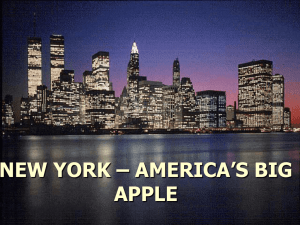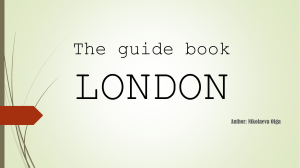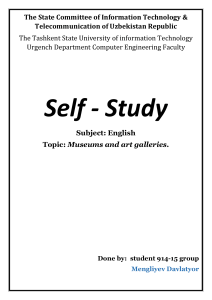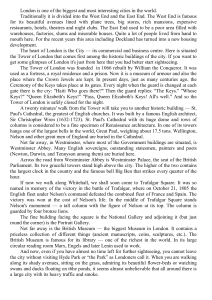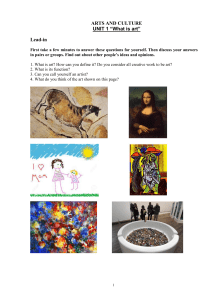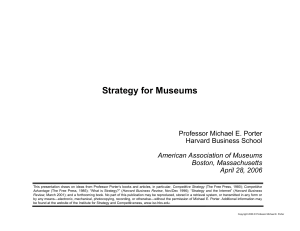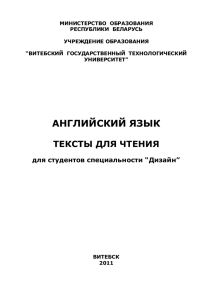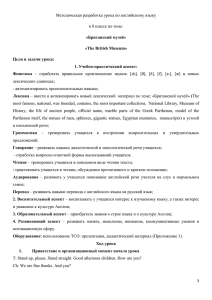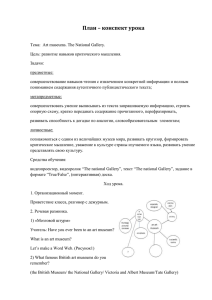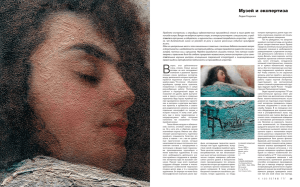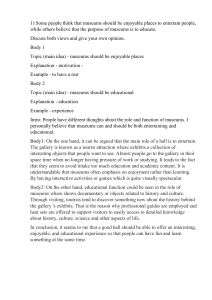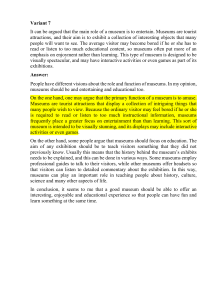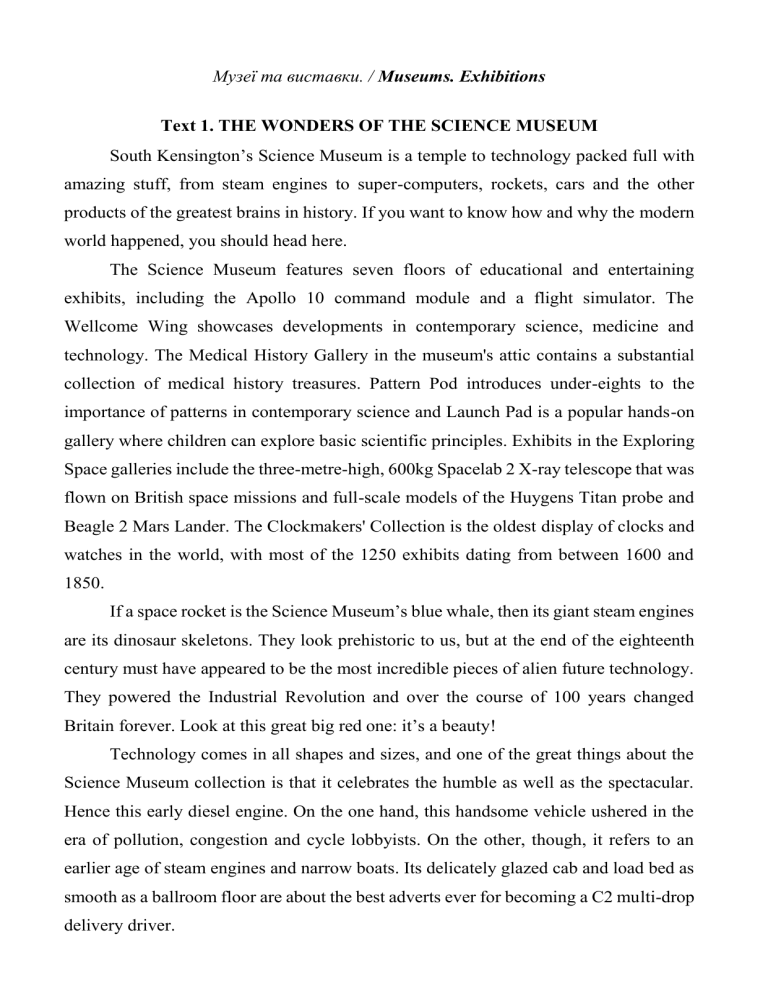
Музеї та виставки. / Museums. Exhibitions Text 1. THE WONDERS OF THE SCIENCE MUSEUM South Kensington’s Science Museum is a temple to technology packed full with amazing stuff, from steam engines to super-computers, rockets, cars and the other products of the greatest brains in history. If you want to know how and why the modern world happened, you should head here. The Science Museum features seven floors of educational and entertaining exhibits, including the Apollo 10 command module and a flight simulator. The Wellcome Wing showcases developments in contemporary science, medicine and technology. The Medical History Gallery in the museum's attic contains a substantial collection of medical history treasures. Pattern Pod introduces under-eights to the importance of patterns in contemporary science and Launch Pad is a popular hands-on gallery where children can explore basic scientific principles. Exhibits in the Exploring Space galleries include the three-metre-high, 600kg Spacelab 2 X-ray telescope that was flown on British space missions and full-scale models of the Huygens Titan probe and Beagle 2 Mars Lander. The Clockmakers' Collection is the oldest display of clocks and watches in the world, with most of the 1250 exhibits dating from between 1600 and 1850. If a space rocket is the Science Museum’s blue whale, then its giant steam engines are its dinosaur skeletons. They look prehistoric to us, but at the end of the eighteenth century must have appeared to be the most incredible pieces of alien future technology. They powered the Industrial Revolution and over the course of 100 years changed Britain forever. Look at this great big red one: it’s a beauty! Technology comes in all shapes and sizes, and one of the great things about the Science Museum collection is that it celebrates the humble as well as the spectacular. Hence this early diesel engine. On the one hand, this handsome vehicle ushered in the era of pollution, congestion and cycle lobbyists. On the other, though, it refers to an earlier age of steam engines and narrow boats. Its delicately glazed cab and load bed as smooth as a ballroom floor are about the best adverts ever for becoming a C2 multi-drop delivery driver. Spark your curiosity in the Science Museum’s new permanent gallery: The Statoil Gallery. The interactive science gallery unravels and exposes the wonders of our everyday world through immersive exhibits, artworks and live shows. Explore the seven themed zones, take part in live experiments led by the gallery’s brilliant team of Explainers, and be inspired by incredible mathematical and scientific phenomena throughout your visit. TEXT 2. The Museum Today Museums have a long history going back to the 3 rd century B.C., when the first known museum was opened in the University of Alexandria in Egypt. Over the years, however, the museum culture has spread to nearly every part of the world and today it has become uncommon to find any country that doesn’t have a museum, no matter how small it may be. This implies that the concept of the museum has become a global concept that has survived the 20th century. The Museum’s Association of the UK agreed a definition in 1998. It says: 'Museums enable people to explore collections for inspiration, learning and enjoyment. They are institutions that collect, safeguard and make accessible artefacts and specimens, which they hold in trust for society.' This definition includes art galleries with collections of works of art, as well as museums with historical collections of objects. It holds the cultural wealth of the nation in trust for all generations and by its function and unique position, It has become the cultural conscience of the nation. In the field of human history museums for long collected the extraordinary as evidence of the past. There was in this a kind of perverted democracy because, of course, many collections, perhaps most, if not all, were assembled by an elite which wished to improve the rest of society. As a result of their historical beginnings in many "developing" nations, museums are seen as places where unwanted objects or materials are deposited; in addition, they are regarded as places where objects associated with idolatry and fetish religions are kept. This negative interpretation of what museums mean has continued to inhibit their development in most countries. In our modern society, it has become necessary and indeed urgent for museums to redefine their missions, their goals, their functions and their strategies to reflect the expectations of a changing world. Museums have proven that they can survive and thrive in the face of digital revolution and economic recession. Today, museums must become agents of change and development: they must mirror events in society and become instruments of progress by calling attention to actions and events that will encourage development in the society. They must become institutions that can foster peace, promote the ideals of democracy and transparency in governance in their communities. These cultural institutions must become a part of the bigger communities that they serve and reach out to every group in the society. Leading museums are becoming surprisingly adept at adding a digital layer to their physical treasures. These institutions are using digital technology and data not just for marketing and social media, but also to enrich the museum experience for visitors, reach new audiences online and transform scholarly research. And there are also new kinds of art being made with digital tools and data. When museums became an established reality over two centuries ago, adaptability and sensitivity to changing needs and requirements of museum attendees became a vital part of their continued viability and longevity. ADDITIONAL VOCABULARY: 1. to hold collections – зберігати (містити) колекції 2. collection of paintings – колекція картин 3. history museum – музей історії 4. museum of art – музей мистецтва 5. archaeological museum – археологічний музей 6. science museum – науковий музей 7. sculpture – скульптура 8. painting – живопис 9. fine arts – витончені мистецтва 10. artist – художник 11. gallery – галерея 12. masterpiece – шедевр 13. painter – художник 14. portrait – портрет 15. painting genres – живописні жанри 16. scenery – декорації 17. historical painting – історичний живопис 18. battle painting – бойовий живопис 19. genre painting – жанровий живопис 20. architectural painting – архітектурний живопис 21. religious painting – релігійний живопис 22. seascape – морський пейзаж 23. landscape – краєвид 24. genre – жанр 25. statue – статуя 26. treasury – скарбниця 27. work of art – витвір мистецтва 28. historical exhibition – історична виставка 29. scientific exhibition – морська виставка 30. zoological exhibition – зоологічна виставка 31. ethnographic exhibition – етнографічна виставка 32. armoury exhibition – виставка озброєнь 33. naval exhibition – виставка морських експонатів Task 1. a) Read the text “The wonders of the Science Museum” and decide whether the following statements are true or false. 1. The Science Museum is a place where you can find most of the inventions of humanity. 2. The Museum exhibitions demonstrate the advancements of contemporary science, medicine and technology. 3. British space missions include the Huygens Titan probe and Beagle 2 Mars Lander. 4. The world oldest collection of clocks and watches has more than 1250 exhibits. 5. The early diesel engine started the age of pollution treatment. 6. The interactive science gallery is an amazing part of seven floors of educational and entertaining exhibits. 7. The visitors can lead mathematical and scientific experiments. b) Choose the correct option A, B, C or D to fill each gap in the sentences. 1. Science Museum is a ________ of technology packed full with amazing stuff. a. holy place b. church c. house d. cathedral 2. In the museum's attic visitors can admire a ________ collection of medical history treasures. a. priceless b. meaningful c. significant d. valuable 3. The giant steam engines _________ the Industrial Revolution. a. specify b. symbolize c. index d. mean 4. The Science Museum collections are demonstrated in a ______of shapes and sizes. a. load b. dozen c. package d. great variety 5. In a new permanent gallery visitors can develop their academic __________. a. value b. interest c. force d. level 6. The interactive science gallery _____ the wonders of our everyday world. a. unwind b. unwrap c. unweave d. unriddle 7. Young visitors explore the themed zones and ________ in live experiments. a. play b. share c. participate d. attend 8. Incredible mathematical and scientific phenomena inspire all comers _________ the visit. a. all-over b. during c. around d. overall Task 2. a) Choose the correct option (a, b, c) to complete the sentences. 1. That fundamental challenge for museums is similar to the one facing …. a) retailers, manufacturers, consumer goods makers and perhaps traditional media companies. b) countries emerging from conflict. c) academic and professional societies in the current century. 2. In the museums, the objects were arranged by subject matter, and …… a) were organized differently every day. b) were typically typologically organized. c) were arranged on each side of a long open hall. 3. As the institution’s role evolves, a universal definition of museum a) has become the subject of heated argument. b) Has emerged from recent work in Art history. c) Means a museum that has incorporated universal design. 4. Museum and Society is an independent peer-reviewed journal which ……… a) features wonderfully minimalist images that incorporate petals, seeds and leaves, intends to spur creativity. b) provides essential sources on the role of society in the urban space. c) brings together new writing by academics and museum professionals on the subject of museums. 5. Along with the identification of a clear role for museums in society, there gradually developed …….. a) maps to enhance meaningful learning in the sciences. b) a body of theory the study of which is known as museology. c) The concept of library and the transformation of libraries to centers of education in its historical development. 6. Art museums display works of art by ……… a) local, national, or international artists and many offer classes in the various disciplines of art. b) Rare objects of natural historical, ethnographic, and art historical interest. c) Collectionsincluded objects that were said to have belonged to “holy persons” of the new Christian pantheon, sacred utensils, icons, and manuscripts. 7. It is common knowledge that many art galleries and museums are finding ……… a) it tough to market to younger, digitally-oriented generations. b) it difficult to play a leading role in important areas of social life. c) a new situation that challenges the present discourse on public services. 8. The use of a historic building as a museum or an art gallery can be ……. a) one of the most appropriate ways of ensuring the future viability of the building. b) considered more broadly than building including natural and man-made formations and does not necessarily have walls. c) The only example of a clean, sustainable building, designed with natural materials, uses little energy and renewable ones. b) Complete the sentences with the correct form derived from a word in brackets. Academic museums share a unique mandate: they are partners in education. As such, they have 1. (EVOLUTION) in tandem - and not always easily - with their parent 2. (ORGANIZE). They can often pursue their 3. controversial topics, 4. (MISS) in innovative ways, address (PRODUCTION) unorthodox exhibitions, and have the freedom to experiment. But they operate within a 5. operations, planning, 6. (CHALLENGE) environment in which (GOVERN), administration, financial support, and fundraising can all become more complex. And in recent years, some colleges and universities have questioned the very need to maintain a museum, while others have attempted to monetize art collections to raise capital. MUSEUMS. EXHIBITIONS. KEYS: Task 1. a) 1.T 2.F 3.F 4.T 5.F 6.T 7.F b) 1.A 2.C 3.B 4.D 5.B 6.D 7.C 8.B Text 2. a) 1. A 2. B 3. A 4. C 5. B 6. C 7. A 8. A b) 1.Evolved 2.organizations 3.missions 4.produce 5.challenging 6.governance
